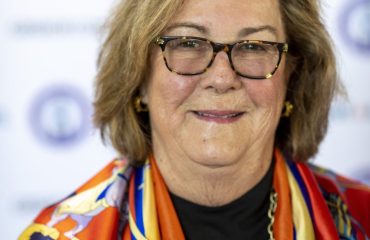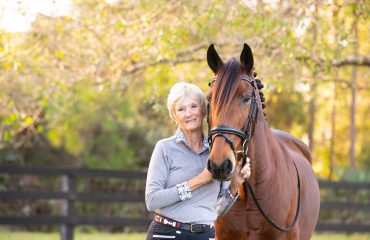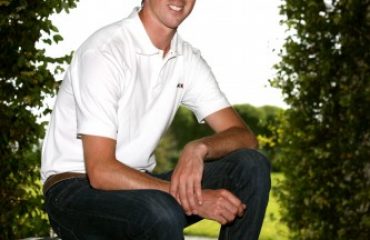
Irish Linen
Oil, Acrylic and Charcoal on Canvas
40″ x 60″
By Rachel Masen
Tanner Jensen is an equestrian artist based in Flagstaff, Arizona. She was born to a family that didn’t understand her love of horses, but always supported her. As a youth, Tanner took inspiration from travel, art books and the paintings in her own home. She studied painting at Northern Arizona University and attended East Carolina University in North Carolina where she studied with Paul Hartley. It was at East Carolina that Tanner was able to balance working with horses and creating art.

Tanner with her late horse, Abe
Part of Tanner’s drive to become an equestrian artist dates back to her childhood. “Do you remember those moments when you were a child and you would see a horse? Those feelings that took your breath away and filled you with sheer joy? I believe every equestrian has experienced them. It’s that feeling that I’m trying to capture with my art,” Tanner said.
What’s your history with horses?
It was love at first sight. I can’t recall a time when I wasn’t mad about horses. I remember watching “National Velvet” for the first time when I was 9. That was it: I wanted to ride in the Grand National. No one in my family was horsey in the least. I’d receive books and prints of horses, but had little to no contact with them until I was 15 and got my first horse. I look back at that time and know it was one of the minor miracles of my life.
Reality about the Grand National settled in, so I evented, only to Training Level but I did get to school the water at Ledyard and a few preliminary fences at Flying Horse, both courses now long gone. When I was young, equine opportunities were plentiful. I had lessons with some of the equestrian greats. I worked for Olympic athletes and I loved it. Unfortunately I was young and didn’t realize what a gift it was until I was much older.
I switched my riding focus long ago to dressage and have been fortunate enough to have ridden and worked some very nice horses. I’m currently without a horse, but hope springs eternal. I hope this year I’ll be looking for my next horse.

The Good Ride
Oil, Acrylic and Charcoal on Canvas
40″ x 60″
Is creating art your day job?
It is now. I’ve worked a variety of horse jobs in the past — wrangler, riding instructor, groom and stable manager. I worked as floral designer for years. I’ve taught art lessons to people from 4 to 84, for parks & recs, art centers, community colleges and universities. I love teaching workshops and plan on teaching more this year. Teaching is so rewarding on so many levels.
What’s your background in art?
I knew when I was 3 years old that all I wanted to do was draw and be around horses. My parents always supplied me with paper, crayons, pencils and paints. When I was 8, my father built me a desk and shelves and told me that this was my studio. It may have been in the garage, but it was mine and made me feel like an artist. I went back to university at 30 and got my bachelor of fine arts in painting, followed by an master of fine arts in painting from East Carolina University where I really started to learn to paint.

Leap of Faith
Acrylic, Graphite and Charcoal on Yupo
17.25″ x 23″
How did the horse become one of your primary subjects?
I love them! When I was a child, I drew them to give an image to what my heart desired. I stopped drawing them as a teenager due to peer pressure. I turned my attention to “serious” subject matter, still life and portraits of anyone who’d sit still for me. One of the people on my BFA committee saw a painting I did of a horse and commented, “Why aren’t you painting horses? This one radiates your love for them.” It was the first time someone I respected
in the art world encouraged me to paint horses. I ran with it!
How did you develop your current style?
I knew I didn’t want to paint horses being ridden or with people. I wanted it to be about the horse. When I was in grad school, I was earning my living teaching riding lessons, mucking stalls and clipping horses. One day when I was turning a very solid hunter back out into the field, his pasture mate called to him. Toby picked up a canter and when he reached his buddy, performed half a canter pirouette. I thought, There it is! I remember being told that all dressage movements are natural to the horse and performed by them when they’re at liberty.

Roses and Violets
Oil on Canvas
34″ x 34″
Describe a typical day.
I only paint by natural light. If the day is dark, I either clean and organize or I stretch canvases and coat them with gesso. If I have good light, I’ll spend 10 minutes or more sitting and looking at an unfinished work. At some point I see what I’m going to start and do. I typically spend six hours a day in the studio.
How do you get inspired?
Inspiration is a funny thing. Sometimes it’s a color, a shadow, a line or an arrangement of objects. Sometimes it’s a phrase or word, a piece of music or a smell. Inspiration is like memory for me. Anything can trigger it and where it leads sometimes feels very random and disconnected. I don’t plan out my painting. I have a vague, general idea of where I want to go. I start working and see where it leads. It’s an adventure of sorts. The hardest part is knowing when to stop.
For more information, visit www.tannerjensenfineart.com
Photos courtesy of Tanner Jensen

Bittersweet
Oil on Canvas
34″ x 34″













